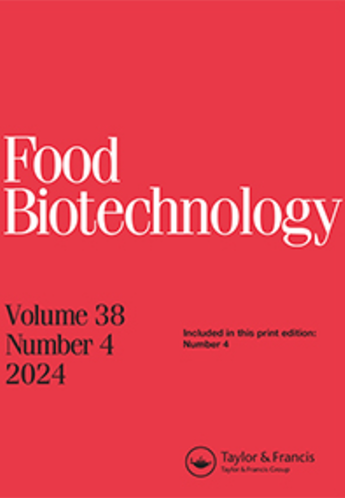乳酸菌和酵母发酵小米和高粱粥的营养状况和抗氧化能力
IF 1.6
4区 农林科学
Q4 BIOTECHNOLOGY & APPLIED MICROBIOLOGY
引用次数: 12
摘要
摘要对谷子和高粱自发发酵过程中分离到的优势乳酸菌和酵母进行了工艺特性和食品安全性研究。监测营养状况和抗氧化能力。麦芽谷子浆和高粱浆的pH值分别降至3.31和3.45。选择发酵乳杆菌KL4、植物芽孢杆菌MOBL1、热带念珠菌OBY6和热带念珠菌MKY6高产乳酸、双乙酰和过氧化氢。这些菌株作为发酵剂是安全的。发酵剂发酵谷子和高粱浆的烟酸、核黄素、总酚类物质和类黄酮含量显著(p < 0.05)高于发酵剂。发酵谷子浆(MKC)的镁和钾含量最高,分别为114.2和212.13 mg/100 g,自发发酵无麦芽高粱浆(OBS)的镁和钾含量最低,分别为40.2和82.3 mg/100 g。发酵谷子浆(MKC)对DPPH的清除活性最高,为98.2%,未发酵高粱浆(OBS)对DPPH的清除活性最低,为60.3%。发酵72 h后,发酵高粱浆(MOBC)的铁还原抗氧化能力最高,为998.3 mg/g AAE,未发酵谷子浆(KS)最低,为260.2 mg/g AAE。无麦芽发酵剂生产的奥吉巴巴(OBC)总体感官接受度最高,为7.50,自发发酵的奥吉巴巴(MOBS)最低,为5.10 (p < 0.05)。结果表明,粗粮中的可可和奥吉巴巴是营养保健品和有发展前景的发酵谷物粥的重要来源。本文章由计算机程序翻译,如有差异,请以英文原文为准。
Nutritional profile and antioxidant capacities of fermented millet and sorghum gruels using lactic acid bacteria and yeasts
ABSTRACT Predominant lactic acid bacteria and yeasts isolated during the spontaneous fermentation of millet and sorghum were investigated for technological characteristics and food safety. Nutritional profile and antioxidant capacities were monitored. The pH reduced in both malted millet and sorghum slurries to 3.31 and 3.45 respectively. Lactobacillus fermentum KL4, Lb. plantarum MOBL1, Candida tropicalis OBY6 and C. tropicalis MKY6 were selected for high production of lactic acid, diacetyl, and hydrogen peroxide. These strains were safe for use as starter cultures. Starter culture fermented malted millet and sorghum slurries possessed significantly (p < .05) higher niacin and riboflavin content, total phenolics and flavonoid contents. Fermented malted millet slurry (MKC) demonstrated the highest magnesium and potassium contents of 114.2 and 212.13 mg/100 g while spontaneously fermented unmalted sorghum slurry (OBS) the least of 40.2 and 82.3 mg/100 g respectively. Fermented malted millet slurry (MKC) possessed the highest DPPH scavenging activity of 98.2%, while the unmalted spontaneous sorghum slurry (OBS) the least of 60.3%. For ferric reducing antioxidant power, the malted starter culture fermented sorghum slurry (MOBC) displayed the highest value of 998.3 mg/g AAE while unmalted spontaneous millet slurry (KS) the least of 260.2 mg/g AAE after 72 h fermentation time, respectively. Unmalted starter-produced Ogi-baba (OBC) exhibited the significantly highest overall sensory acceptability of 7.50 while the least was the spontaneous fermented malted Ogi-baba (MOBS) with a value of 5.10 (p < .05). The results indicated that Koko and Ogi-baba from whole grains are important sources of nutraceuticals and promising fermented cereal gruels.
求助全文
通过发布文献求助,成功后即可免费获取论文全文。
去求助
来源期刊

Food Biotechnology
工程技术-生物工程与应用微生物
CiteScore
3.80
自引率
0.00%
发文量
15
审稿时长
>12 weeks
期刊介绍:
Food Biotechnology is an international, peer-reviewed journal that is focused on current and emerging developments and applications of modern genetics, enzymatic, metabolic and systems-based biochemical processes in food and food-related biological systems. The goal is to help produce and improve foods, food ingredients, and functional foods at the processing stage and beyond agricultural production.
Other areas of strong interest are microbial and fermentation-based metabolic processing to improve foods, food microbiomes for health, metabolic basis for food ingredients with health benefits, molecular and metabolic approaches to functional foods, and biochemical processes for food waste remediation. In addition, articles addressing the topics of modern molecular, metabolic and biochemical approaches to improving food safety and quality are also published.
Researchers in agriculture, food science and nutrition, including food and biotechnology consultants around the world will benefit from the research published in Food Biotechnology. The published research and reviews can be utilized to further educational and research programs and may also be applied to food quality and value added processing challenges, which are continuously evolving and expanding based upon the peer reviewed research conducted and published in the journal.
 求助内容:
求助内容: 应助结果提醒方式:
应助结果提醒方式:


